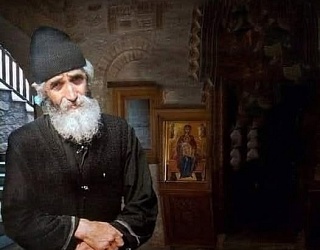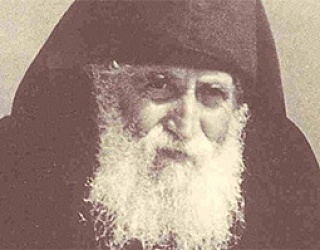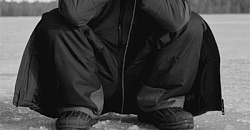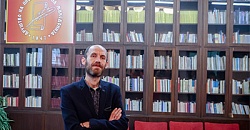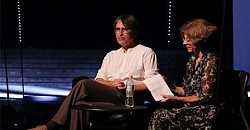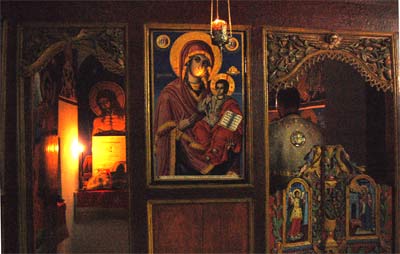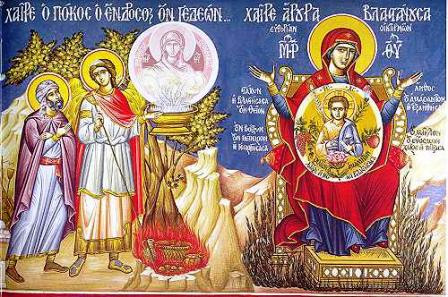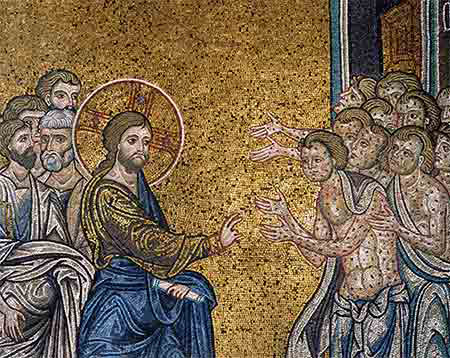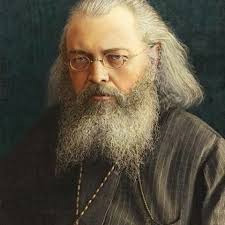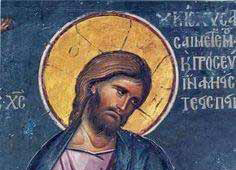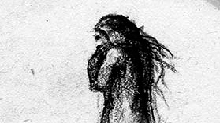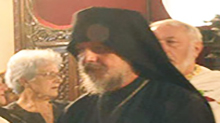“You are the God who creates miracles"
The story of The Miraculous Lady of Cicero, Illinois
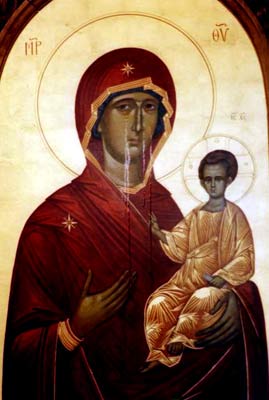
Miracles ... why are we dubious of them, when we know that they are a big part of our Orthodox Christian heritage? From the doctrines of the Holy Trinity and God’s Incarnation, to honoring the Most Holy Virgin Mary as the Mother of God who, similar to Her Son, underwent a bodily resurrection on the third day after Her dormition (repose) and now resides in Heaven, the Orthodox Christian Religion is anything but limited in terms of miracles. Even though they are included in the Gospels, it is still rare for some of us to ever expect, moreover to witness something “miraculous” happening right before our eyes. Although many of us may claim to believe in those miracles of the past, we still find ourselves doubtful of their occurrence today in the 21st century. They just don’t occur now ... not in Chicago, Illinois.
Some of the parishioners of St. George Antiochian Orthodox Church in Chicago (Cicero) may have had the similar skeptical attitude prior to April 22, 1994. However, what happened that evening, not only changed their feelings, but also changed their lives. Furthermore, it had a profound effect on the thousands of people who have since joined in the spiritual experience that began to unwrap that day. This spectacular occurrence was the weeping of one of the icons of the Mother of God, the icon that is now known as “The Miraculous Lady of Cicero”.
Through this story of “The Miraculous Lady of Cicero”, and of course, with God’s help, the existence of miracles will be thoroughly presented and observed, and all the skepticism will be inevitably diminished.
The weeping icon of the Mother of God is just one of the many icons that have been categorized as wonder-working or miracle-working icons. Our Orthodox Christianity counts numerous appearances of icons that display supernatural invasion of the natural order: icons that weep, myrrh-streaming icons, as well as icons that have been shedding bloody tears.
What happens when icons “weep?” This is wonderfully described in Archpriest Paul O’Callaghan’s article “Why do icons weep”: “in most cases, a moist dew-like substance begins to form on the icon and then begins to stream down it. On many weeping icons, the moisture develops in the eyes only, and then wells up like tears do in person eyes, before flowing down the icon in distinct streams. The substance itself is of an oil-like consistency, and at times has a distinctly fragrant odor to it.” In his article, the Archpriest talks about different types and origins of weeping icons. He mentions that some of them are original paintings, while others are solely reproductions, amongst them even “inexpensive paper prints mounted on wood”.
The weeping icon of Cicero is an original painting done on the iconostas of the Church. As Archpriest Nicholas Dahdal, the Pastor of Saint George Antiochian Orthodox Church told me, it was painted during 1982-1983 by a Canadian iconographer Theodor Koufos. (St. George Antiochian Church was founded in Oak Park in 1966, but relocated to Cicero in 1984.) Father Nicholas said that the icon started weeping on April 22, 1994, at six o’clock, on the eve of both St. George's feast and the great Christian holiday, Lazarus Saturday, two days before Orthodox Palm Sunday. He was actually present at the time when the icon started weeping. He told me that he felt both wonderful and grateful to be part of that remarkable spiritual event. During the evening service, besides father Nicholas there was also a visiting priest, Father Douglas Wyper, and a few parishioners. A small stream of fluid on the Icon of the Blessed Virgin and Mother of God caught their attention. Soon after, right before the eyes of hundreds who had arrived to witness this phenomenon, there were four streams that extended to the bottom of the Icon. According to Father Nicholas, the icon wept continuously for 6 months, and only occasionally afterwards.
As stated in the book “Weird Illinois: Your Travel Guide to Illinois' Local Legends and Best Kept Secrets”, eight orthodox bishops examined the tears and declared them to be genuine. Soon after, Metropolitan Philip, Primate of the Antiochian Orthodox Christian Archdiocese of North America, issued a letter to his congregations where he said: “We have heard from several people in that community of miraculous healings taking place after they were anointed with the soft tears. We dare not explain this phenomenon… We can only repeat here one of the salutations from the Akathist Hymn: "Hail, thou that provest logicians illogical," and accept this miraculous event with faith and joy. This is indeed her gift to all of us during this holy season. I therefore designate this Icon of the Theotokos at St. George Antiochian Orthodox Church as "The Miraculous Lady of Cicero, Illinois," and encourage our faithful everywhere to seek her intercessions…”
I had a chance to see the Miraculous Lady of Cicero Icon, and I thought that it was extremely beautiful. Based on the knowledge that I have obtained about Orthodox iconography, I would like to mention that there are many types and styles of icons of the Mother of God. The Weeping Icon of the Holy Virgin at St. George Antiochian Orthodox Church belongs to a group of icons known as “Hodigitria” in Greek, or, in English translation, “the Directress” meaning “the one who points the way.” According to the ancient tradition of the Church, the first “Hodigitria” was painted by the holy apostle and evangelist Luke. The name “Hodigitria” was given to it in the 9th Century. It is said that the Mother of God, Herself, gave her blessing to this painting.
Typically for these icons, the Christ Child always appears seated upright on His Mother’s left arm. The Infant is shown as Pre-Eternal God, full of wisdom. He holds a scroll in His left hand while giving a blessing with His right hand. The Mother of God is depicted in a majestic fashion. Her right hand is pointing towards Her Son, to direct its viewers to acknowledge His importance.
When it comes to the Miraculous Lady of Cicero Icon, one of the most frequently discussed aspects of this topic has, of course, been the question of the authenticity of the miracle. There are skeptics who believe that the whole thing is an exercise
in fakery and trickery. Before I saw the icon, I was one of these people, being an intellectual whose education prevents him from taking miracles for granted. However, that inevitably changed after visiting the church, seeing the Icon and interviewing Father Nicholas, which was nothing short of both, excitement and enlightenment.
Based on my previous attitude towards miracles, I know that the assumption that the weeping icons are a manifestation of Divine Grace is often taken with disbelief. People usually search for hidden reservoirs, pumps, and conduits that would prove it all to be a hoax. However, the thorough research I conducted helped me learn that weeping icons have been known to the Orthodoxy many centuries ago, even at times when such technology was unknown, let alone being used! On the other hand, isn’t it a little strange to imagine priests or other members of the clergy working on such conspiracy? And what would they achieve by that? Furthermore, the icon of Cicero started weeping during a great Orthodox Feast, when hundreds of people must have been present in Church. Would someone really risk producing artificial tears on the icon in front of so many people? The ones who know the life and history of the Orthodox Church must find this entirely bizarre. Additionally, Father Nicholas mentioned that there was an interesting reportage about the Cicero Icon, made by Channel 7. Namely, during the months when the Icon was still weeping, they recorded what was behind the Icon to prove and convince the viewers that there is nothing human manufactured, such as pipe line etc. that would produce the tears.
Various agnostic theories promote claims that there are some natural processes occurring in the material itself which the icon I made from that explains it all. However, as I mentioned earlier in my writing, there is a variety of materials found in the
weeping icons. No one procedure could account for it all, when such
different materials are involved. Some of them are even paper prints, and solely the fact that they do not get ruined by the fluids that come from them says a lot! As I was doing my research, I learned that the majority of weeping icons are the ones of the Mother of God. Here another important question arises: If there wasn’t a special purpose known only to God Himself, why would the subject be limited to the icons of the Most Holy Virgin Mary? Isn’t the constitution of Her icons similar to all others?
What about the failure to find a logical explanation for the numerous healings, alluring fragrances, and enlightened spiritual atmosphere experi¬enced by people in the presence of the weeping icons? Isn’t this an important indicator that Divine Grace does exist?
There are some skeptics who neglect all that has been previously stated in defense of the icon, and stubbornly insist on the necessity of scientific tests. The REALL News Magazine columnist, David Bloomberg, claims that proper scientific testing needs to be performed on the icon in order for it to be proclaimed an “official miracle.” When I spoke to Father Nicholas regarding this matter, he informed me that media and science researchers were initially interested in verifying the authenticity of the icon; however, the enthusiasm to do so diminished right after Metropolitan Philip officially announced that such scientific “investigations” were welcome.
Something that I believe is also important to mention here, are Father Nicholas’ words that Christians should not limit their faith to miracle-working icons such as the Icon of Cicero, because such manifesta¬tions can never be equivalent to divine faith. He pointed out that miracles are all around us, they happen every day; we just need to open our spiritual eyes and see them.
During my research I came across numerous reports of miraculous healing from the Icon. When I was interviewing Father Nicholas, he shared with me a story about a man who was bringing bread to St George church every week. This man first arrived at the church in a wheelchair, he couldn’t walk, but after visiting the Icon he was healed! The priest also told me that he still vividly remembers the very first miraculous healing that came from the icon. Namely, in the month of June, 1994, a lady came to his church; vary frail, very skinny, asking for a blessing. She suffered from acute failure. In less than a -month she returned to the church with flowers, completely healed! She was originally treated in Northwestern Hospital. When she was examined after her miraculous healing, the doctors were astonished to conclude that her recovery isn’t due to any cure from modern medicine; a miracle had indeed taken place!
What I previously wrote regarding miraculous healings may sounds almost like a standard, a cliché, but the information that I further gathered from the interview with Father Nicholas really caught my interest. After briefly mentioning the rumor about a notorious Chicago gang member who turned his back on gang life after seeing the icon, the Priest passionately described to me a remarkable event. He spoke about the evening of December 10th, 1997 when a fire broke out at approximately 6:00 p.m. in the front portion of the altar area of the Church. “…The church burned down, almost completely. After Cicero firemen had put the fire out, one of the firefighters came walking out of the burned remains of the church holding the Icon which was completely untouched by the fire,” According to Father Nicholas, after the fire the Icon was moved to a temporary location. During this time it didn’t weep, but it started weeping again literally on the way back to the remodel church. Father Nicholas says that for some who didn’t believe in the miracle of the Weeping Icon before this fire, the fact that the Icon was the only relic to survive the untamable flames, might have changed that.
Since April 22, 1994 to present day, thousands of people have been visiting St. George Church to view the Weeping Icon. In the Milwaukee Sentinel Magazine issued in July of 1994, it was stated that within two months since the icon first started weeping, “120,000 people have visited the icon, standing in a line that, at times, extended down more than a block down the street”. Ten of thousands have made pilgrimages to the Church to pray before the Miraculous Weeping Icon, Our Lady of Cicero. And even today, more than sixteen years later, the faithful continue to arrive. Pilgrims from all walks of life, of all ages, and of all faiths have visited St George Church to view the miraculous sign. As Archpriest Nicholas told me, they come for a variety of reasons. Some come out of curiosity; others come looking for miracles in their own lives. Still others come merely to pray and meditate before the Icon of the Mother of God. Among the ones mentioned last, according to Father Nicholas, Catholics and Hispanics are most abundant, primarily because they deeply venerate the Mother of God. I imagine that, at times, such continuous visits can be even overwhelming for the clergy of St George Church, but based on my personal experience, I am certain that they warmly welcome everyone who comes to see the Icon.
An article published in the Cicero Town Magazine stated that in May of 2010 the Town President Larry Dominick and the Town Board approved a Resolution commemorating the 16th Anniversary of the Weeping Icon of the Virgin Mary (The Miraculous Lady of Cicero). President Dominick praised St. George Antochian Church saying, “We are blessed to have this miracle in our community, a miracle that brings hope for all those in need.” The Resolution had been accepted by Archpriest Nicolas Dahdal, on behalf of St.George church.
Although the icon of Cicero has been generally viewed as a wonderful miracle, many seem to see the weeping as a bad sign. Yet, there are many who see this phenomenon purely as manifestation of God’s grace.
The subdeacon of St George Antiochian Church (the home of the Icon of Cicero) has stated: “To answer the question as to whether or not Our Lady's weeping is good or bad, all I can say is that the people here still disagree over that. Many wonderful things came out of the miracle; even today people are physically and spiritually healed by her tears and by prayers in front of her icon. But, considering that most of our flocks are Lebanese or Palestinian, her tears may have been an omen of horrors that were to come to those lands. “
Father Nicholas believes the icon is a message from God. "Ours is an Orthodox congregation. I am a Palestinian. Most in our Church are from the Middle East. This is a very troubled part of the world. I believe the Icon is giving us a wake-up call -- telling us to pray for the world. The world is not doing very well." He mentioned to me that he doesn’t see happiness in the eyes of the Icon, and that many times he had prayed for it to stop weeping.
One parish letter posted on St. Luke the Evangelist Orthodox Church website reads: “We the parishioners of St. George Church are humbled by the Lord's presence and feel unworthy of this honor. We pray that we may be guided as we attempt to respond to this clear message. We ask all those who read this - sons and daughters of the most Loving and Blessed Mother - to help us remove the cause of Her agony. Let us shun violence, hatred and immorality. TOGETHER WE CAN MAKE A DIFFERENCE, and together we will turn the ‘Weeping Icon’ into tears of joy”.
In his article “Why do icons weep” posted in the Word Magazine, Archpriest Paul O’Callaghan states that even though typically weeping icons are immediately associated with sorrow, there is a difference when it comes to the Miraculous Lady of Cicero. He points out that the fluid coming down from the eyes of the Mother of God is not watery, but oily and fragrant. He further explains that in the tradition of the Church that type of substance is generally referred to as “myrrh”, which is considered to be a healing balm. In Archpriest O’Callaghan’s words: “the fact that the Virgin weeps myrrh would then mean she is pouring out mercy and compassion for the human race in need of healing and grace. So, in this line of interpretation, the weeping is not so much a statement that the world is in a uniquely evil condition, but a reminder that the mercy, grace, and healing power of the Holy Spirit are still with us in the Church, by the intercessions of The Mother of God”.
Who could possibly state with certainty why we were given this miraculous sign? Even though no one can confidently say why the Mother of God’s icon shed tears, we can at least confidently recognize this phenomenon as a miracle of God, sent to us with an enlightening purpose. In regard to this, Bishop Demetri of the Antiochian Archdiocese has said: "Miracles are done by God to teach us and to encourage us and to strengthen our faith. Christianity began with miracles, we believe in miracles and we believe they happen continuously."
Writing this essay brings back beautiful feelings. It brings the very same sensation I experienced when standing in the near proximity of the Icon and looking into the eyes of The Mother of God. I remember feeling completely insulated, with the physical surroundings becoming void, and a surge of conscience telling me: you are not alone.
Her eyes knew that I was seeking for the truth and literally tracked my every movement. As I followed down the long streaks of residue, chills from within overtook my body, disarmed me and made me motionless.
Now, even with my eyes closed, I can still feel the Mother of God’s eyes looking at me, poking through my soul. I stopped wondering, I’m no longer seeking for answers. The proverb “I’ll believe it when I see it” came a long way, surpassing all the boundaries previously embodied in me, transcending all agnosticism and transforming into an acceptance of the powerful doctrine of God created miracles. Now it is immortalized with this essay.
Dejan Duranski



